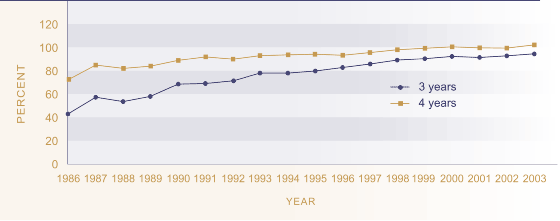Relevance
Evidence from New Zealand and international research shows that the early years of childhood are vital to a child's development and future ability to learn.33 Quality early childhood programmes prepare young children socially, physically, and academically for entry into primary education and can help narrow the achievement gap separating children from low-income families from more advantaged children.
Current Level and Trends
As at 1 July 2003, the 'apparent' early childhood education participation rate for 3-year-olds was 94 percent and for 4-year-olds it was 102 percent, indicating that some 4-year-olds attend more than one service. These figures represent a substantial increase from 43 percent and 73 percent respectively in 1986. Much of the growth in participation in early childhood education occurred in the five years between 1986 and 1991 with slower growth in subsequent years.
Figure K1.1 Early childhood education
'apparent' participation rate, 3-4 year olds, 1986-2003 years

Source: Ministry of Education,
Ministry of Social Development
Note: These figures overestimate the true participation rate. Rates in
excess of 100 percent are possible, because children can be enrolled in
more than one service
A new measure of early childhood education participation, which avoids the problem of double-counting, comes from information collected when children are in Year One at school. This shows that, as at July 2003, 94 percent of all Year One students had attended some form of early childhood education service before starting school. This compares with 91 percent of Year One students in 2000.
Ethnic Differences
There are marked ethnic differences in the proportion of Year One students who had attended an early childhood education service, with European students being the most likely to have attended: 97 percent compared with 88 percent of Māori and 83 percent of Pacific Year One students in 2003. However the gap in participation rates declined in the three years to 2003.
Table K1.1 Early childhood education attendance by Year One students, by ethnic group, as at 1 July 2000-2003
| European | Māori | Pacific | Asian | Other | Total | |
|---|---|---|---|---|---|---|
| 2000 | 95.4 | 84.8 | 76.1 | 89.2 | 83.0 | 91.0 |
| 2001 | 96.0 | 85.3 | 76.3 | 89.8 | 84.1 | 91.3 |
| 2002 | 96.6 | 86.5 | 79.4 | 92.1 | 86.6 | 92.3 |
| 2003 | 97.4 | 88.4 | 83.4 | 92.4 | 88.9 | 93.5 |
Source: Ministry of Education
Note: These figures exclude cases for which attendance was unknown and
differ from those published in The Social Report 2003
Participation by Type of Early Childhood Education Service
In 2003, childcare centres (40 percent) and kindergartens (39 percent) catered for the largest group of enrolments of 3- and 4-year-olds in early childhood education. Much smaller proportions were enrolled in play centres (six percent) and kōhanga reo (5 percent).
